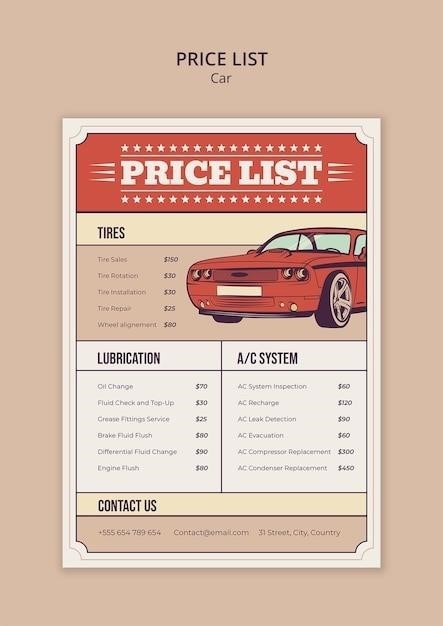This comprehensive guide will take you through the process of swapping an LS engine into your Chevy Colorado․ We’ll cover everything from choosing the right engine to wiring and tuning, so you can unleash the full potential of this powerful platform․
Introduction
The Chevrolet Colorado, a popular mid-size pickup truck, is known for its versatility and capability․ However, some enthusiasts seek more power and performance from their Colorados․ Enter the LS engine swap, a popular modification that transforms the Colorado into a true performance machine․ LS engines, renowned for their power and reliability, are a perfect fit for the Colorado, offering a significant upgrade in horsepower and torque․
This guide will walk you through the process of performing an LS swap in your Chevy Colorado, providing detailed information on every step of the way․ From selecting the right engine and transmission to wiring and tuning, we’ll cover everything you need to know to successfully complete this ambitious project․ Whether you’re a seasoned mechanic or a first-time builder, this guide will serve as your comprehensive resource for an LS swap․
Get ready to unleash the power of an LS engine in your Chevy Colorado and experience a thrilling ride like never before․ The journey ahead will be rewarding, transforming your Colorado into a true performance icon․
Why Swap an LS Engine?
Swapping an LS engine into your Chevy Colorado offers a multitude of advantages that make it a popular choice for enthusiasts․ The LS engine’s reputation for power and reliability is legendary, making it the perfect choice for those seeking a significant performance upgrade․
The LS engine boasts a compact size and lightweight design, making it ideal for fitting into the Colorado’s engine bay without compromising on space․ This allows for a clean installation without requiring extensive modifications․ Furthermore, the LS engine’s modular design simplifies the swap process, with readily available parts and accessories to suit your needs․
The LS engine is also renowned for its exceptional power output, delivering a substantial increase in horsepower and torque compared to the stock Colorado engine․ This translates to a more exhilarating driving experience, with improved acceleration and towing capabilities․ Whether you’re hitting the trails or cruising the highway, the LS engine will transform your Colorado into a performance beast․
Choosing the Right LS Engine
Selecting the right LS engine for your Chevy Colorado swap is a crucial step in the process․ Consider your intended use for the vehicle and your budget to determine the optimal engine choice․ The most popular LS engine for swaps is the 5․3L Vortec, known for its balance of power and affordability․
For those seeking maximum power, the LS1, LS6, or LS2 engines are excellent options․ These engines offer higher horsepower and torque outputs, but come at a premium price․ If fuel efficiency is a priority, the 4․8L LS engine is a solid choice, offering decent power while maintaining relatively good fuel economy․
When evaluating engines, pay attention to their year of manufacture․ Later model LS engines, such as those found in the 2007 and later models, feature improved fuel efficiency and emissions technology․ However, older LS engines may be more readily available and offer better value for the money․ Ultimately, the best LS engine for your Colorado swap depends on your specific needs and preferences․
Engine Mounts and Accessories
Once you’ve chosen your LS engine, you’ll need to address mounting and accessory compatibility․ LS engines are renowned for their modularity, but some adaptations are required for a Chevy Colorado installation․ Finding suitable engine mounts is essential for proper engine alignment and vibration control․
Several companies specialize in LS swap mounts for the Colorado, offering both bolt-on and custom solutions․ When selecting mounts, consider the specific LS engine you’ve chosen and the desired ride height․ Accessory compatibility is another important factor․ LS engines come with a range of accessory configurations, including different alternator, power steering, and air conditioning setups․ You’ll need to ensure your chosen LS engine’s accessories are compatible with your Colorado’s existing systems or find suitable replacements․
For a seamless integration, consider purchasing a complete LS swap kit that includes engine mounts, accessories, and mounting hardware․ These kits streamline the installation process and ensure compatibility with your Colorado․ Thorough research and planning are key to selecting the right engine mounts and accessories for a successful and trouble-free LS swap in your Chevy Colorado․

Transmission and Drivetrain
Choosing the right transmission and drivetrain components is crucial for a successful LS swap in your Chevy Colorado․ The LS engine’s power output and your intended use for the truck will influence your decision․ Consider the options available and their compatibility with your existing drivetrain․
A popular choice for LS swaps is the GM 4L80E automatic transmission, known for its durability and ability to handle high torque․ Alternatively, the 4L60E is a smaller and lighter option, suitable for less demanding applications․ For those seeking a manual transmission, the T56 six-speed is a popular choice, offering a more engaging driving experience․ When selecting a transmission, it’s essential to ensure compatibility with the LS engine’s bell housing and your Colorado’s existing drivetrain․
The drivetrain components, including the driveshaft, axles, and differential, also need consideration․ You may need to replace or modify these components to accommodate the LS engine’s power and torque output․ For example, upgrading the rear differential to a stronger unit can handle the increased stress from the LS engine․ Careful consideration of the transmission, drivetrain components, and their compatibility with your LS engine and Colorado ensures a seamless and reliable powertrain setup․
Wiring and Electronics
The wiring and electronics aspect of an LS swap can be complex, but with careful planning and execution, it can be manageable․ The goal is to integrate the LS engine’s wiring harness into the Colorado’s existing electrical system, ensuring proper communication and function for all components․ This involves understanding the LS engine’s wiring diagram, identifying key connections, and adapting them to your truck’s existing system․
You’ll need to address the engine control unit (ECU), which is responsible for managing various engine functions․ You’ll either need to utilize the LS engine’s stock ECU, requiring modifications to make it compatible with your Colorado’s systems, or consider an aftermarket ECU specifically designed for LS swaps․ Properly connecting the ECU to the necessary sensors, actuators, and wiring harness ensures smooth operation of the engine․

The wiring process involves splicing, soldering, and potentially using a wiring harness adapter․ It’s recommended to consult with experienced LS swap enthusiasts or professionals for guidance and ensure proper wiring connections․ Accurate wiring and electronic integration are vital for a safe and reliable LS swap, allowing the engine to perform optimally and integrate seamlessly into your Colorado’s existing systems․
Exhaust System
The exhaust system is a crucial part of any LS swap, as it plays a vital role in performance, sound, and emissions․ You’ll need to choose an exhaust system that’s compatible with the LS engine and fits the Colorado’s chassis․ The stock Colorado exhaust system is unlikely to be compatible with the LS engine, so you’ll likely need a custom or aftermarket exhaust system․
Consider factors like header design, pipe diameter, muffler choice, and catalytic converter compatibility․ Headers are a key component of the exhaust system, and they can significantly affect performance and sound․ Choosing the right headers for your LS swap will depend on your desired performance level and sound characteristics․
The exhaust system should be designed to manage exhaust gases efficiently and minimize backpressure․ A well-designed exhaust system will improve engine performance and fuel efficiency while delivering a satisfying exhaust note․ Remember to comply with local emissions regulations when selecting and installing your exhaust system․ A properly designed and installed exhaust system will enhance your LS swap’s performance and sound, while ensuring proper emissions control․
Cooling System
The cooling system is essential for keeping the LS engine running at its optimal temperature, especially under demanding conditions․ The stock Colorado cooling system may not be adequate for the LS engine, as it might not be able to handle the increased heat output․ You’ll need to upgrade the cooling system to ensure proper temperature regulation and prevent overheating․
Consider upgrading the radiator, fan, and thermostat to handle the LS engine’s heat․ A larger radiator with a higher cooling capacity will help dissipate heat more efficiently․ A more powerful fan will provide better airflow through the radiator, further enhancing cooling․ An appropriate thermostat will ensure the engine reaches operating temperature quickly and maintains a stable temperature․
You might also need to modify the cooling system’s hoses and plumbing to accommodate the LS engine’s components․ A properly designed cooling system will ensure the LS engine runs cool and reliably, enhancing its performance and longevity․ Don’t overlook the importance of a proper cooling system when performing an LS swap, as it’s crucial for maintaining engine health and preventing overheating issues․
Fuel System
The fuel system is crucial for delivering a consistent and adequate supply of fuel to the LS engine․ The stock Colorado fuel system may not be sufficient for the LS engine’s higher fuel demands, especially if you plan on adding modifications for increased performance․ Upgrading the fuel system is essential to ensure proper fuel delivery and prevent fuel starvation․
Consider upgrading the fuel pump, fuel lines, and fuel injectors to handle the LS engine’s requirements․ A high-flow fuel pump will provide the necessary fuel volume and pressure to meet the engine’s demands․ Larger fuel lines will allow for increased fuel flow, reducing restrictions and ensuring consistent fuel delivery․ Higher-flow fuel injectors will deliver the correct amount of fuel to each cylinder for optimal combustion․
You might also need to modify the fuel tank and fuel rails to accommodate the LS engine’s fuel system․ A properly upgraded fuel system will ensure the LS engine receives the necessary fuel for optimal performance and efficiency․ Don’t neglect the fuel system when performing an LS swap, as it’s a vital part of the engine’s overall functionality․
Performance Tuning
Once you’ve successfully installed the LS engine and addressed all the necessary components, it’s time to unleash its true potential through performance tuning․ This crucial step ensures optimal engine performance, power delivery, and fuel efficiency․ While a stock LS engine offers a significant power increase over the Colorado’s original engine, tuning can unlock even more horsepower and torque․
The most common method for tuning an LS engine is through a custom tune․ This involves using a tuning device to adjust the engine’s parameters, such as fuel mapping, ignition timing, and throttle response․ A custom tune tailored to your specific LS engine, modifications, and driving style can significantly enhance performance․ It can improve throttle response, increase horsepower and torque, and optimize fuel consumption․ You can achieve a more responsive and efficient engine with a well-tuned LS swap․
Consider working with a reputable tuning shop specializing in LS engines․ They can provide expert guidance, a custom tune, and ensure optimal performance and reliability․ Performance tuning is a crucial part of the LS swap journey, allowing you to extract the maximum potential from your engine and transform your Colorado into a true performance truck․
Safety Considerations
While an LS swap can dramatically enhance your Chevy Colorado’s performance, it’s essential to prioritize safety throughout the entire process․ A well-executed LS swap should not compromise the vehicle’s structural integrity or safety features․ Always prioritize safety and follow best practices during installation and modification․
One crucial aspect is ensuring proper engine mounting․ The LS engine must be securely mounted to the frame, preventing movement and potential damage․ Improper mounting can lead to engine vibration, stress on components, and even engine failure․ Use high-quality engine mounts designed specifically for LS swaps in your Colorado, and consult with a professional if you have any doubts about the mounting process․
Additionally, pay close attention to the exhaust system․ A poorly designed or installed exhaust system can create leaks, increase noise levels, and potentially lead to dangerous carbon monoxide buildup․ Ensure the exhaust system is properly routed, securely fastened, and free of leaks․ Regularly inspect the exhaust system for damage or leaks, and address any issues promptly․
Lastly, remember that modifying a vehicle can affect its handling characteristics․ Consider the added weight of the LS engine and the increased power output․ If necessary, adjust the suspension components to ensure safe and predictable handling․ A well-maintained and correctly tuned LS swap can provide both performance and safety, allowing you to enjoy your Colorado without compromising your safety․
An LS swap in a Chevy Colorado is a rewarding project for enthusiasts seeking to transform their truck’s performance․ By carefully planning, selecting the right components, and executing the installation with precision, you can unlock the full potential of this powerful engine platform․ The LS engine’s reputation for reliability, power, and affordability makes it an ideal choice for a wide range of Colorado owners․
Remember, a successful LS swap is about more than just installing the engine․ It’s about creating a well-integrated system that delivers both performance and reliability․ From choosing the right engine and transmission to addressing safety considerations and tuning for optimal performance, every step plays a vital role in achieving your desired outcome․ With proper planning, attention to detail, and a passion for performance, you can create a truly exceptional Chevy Colorado that turns heads and delivers thrilling driving experiences․
This guide has provided you with a solid foundation for your LS swap journey․ By carefully considering the information presented, you can make informed decisions and ensure a successful project․ Don’t hesitate to consult with experienced professionals or online resources for additional guidance and support․ Most importantly, enjoy the process and the rewards of transforming your Colorado into a high-performance machine․
